Chinese Imperial Clothing
Introduction
Text-to-speech Audio
Dress in the Qing Imperial Court...
Dragon Robes...
A member of the Imperial Court may have worn this blue silk robe in the late 1800’s during the Qing Dynasty. Eight dragons, symbols of the emperor’s power, are woven or embroidered on the outside of the robe, while a ninth dragon is inside to protect his heart. The dragons are known as imperial dragons because they have five claws. Such five-clawed dragons could only be worn by the imperial family and members of the imperial court...
Dragon robes are rich in symbolism. The most significant features are symbols for the parts of the universe ruled over by the Chinese emperor under his mandate from heaven. The striped area at the hem represented his rule over the oceans and its waves. Above that came the land with its mountains, and the sky with its clouds. Taken together, these were also symbols of the permanent unity and prosperity of the empire. Other symbols abound, including one with a meaning opposite to that in the west: the bat. While in the west the bat symbolizes misfortune, in China bats are symbols for happiness and good fortune...
At one time the court’s demand for new robes of all types kept 100,000 weavers working on 7,000 looms. Thousands of embroiderers were needed to further embellish the robes. Of these, dragon robes were the most elaborate. It is estimated that two and a half years of labor were required for one dragon robe...
Fine silks were worn by imperial court members since the early Han dynasty (206 B.C.E. – 220 C.E.). Long before that, the thin fibers of the mulberry silkworm’s cocoon had been discovered and woven into fabric. Early evidence has been found in China of silk production that dates as far back as 3630 B.C.E., during the Neolithic period. Silk production rapidly spread all over China, and lengths of silk eventually became China's most successful trading commodity along the Silk Road. Even the name of the Silk Road is derived from the lucrative trade in silk that dominated its network of overland trade routes between China, India, and Europe. Today, China remains the largest producer and exporter of silk in the world...
The blue dragon robe on display can only hint at what Margaret Howard collected. In the category of Chinese clothing alone there are 41 robes, 20 jackets, 40 skirts, 98 sleeve bands, and 22 collars, all silk and beautifully embroidered. Most of the silk pieces in the collection date from the late 19th century to the end of the Ching dynasty in 1912. Since textiles can be damaged when exposed to light, only a few can be exhibited at one time and then for no more than six months. After that, they are rotated back into the temperature-controlled vault. In the photographs are examples from each of these categories...
Click on the first photo to view the slide show.
Images
Blue imperial dragon robe with black sleeves and horsehoe cuffs.
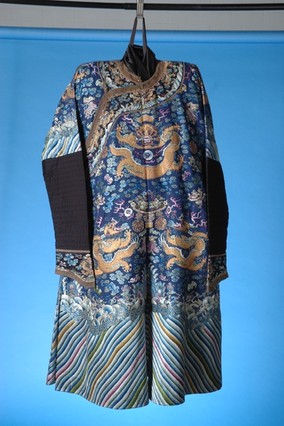
Only the emperor and his family could wear a gold robe.
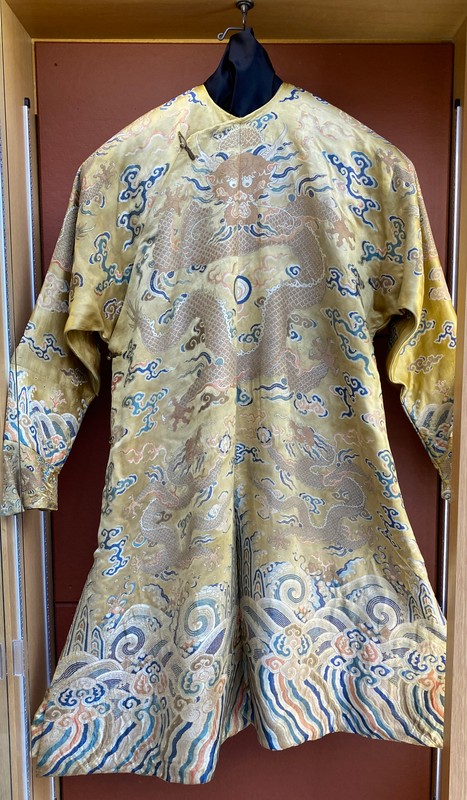
Gold Imperial Robe Back
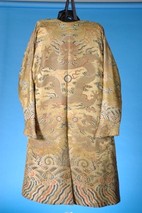
The gauze dragon robe would have been worn during the summer.
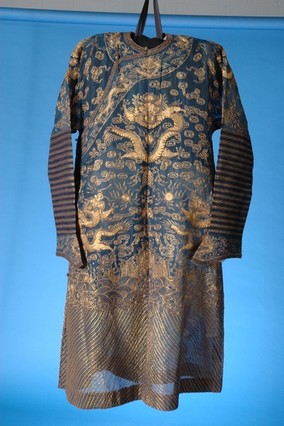
A member of the imperial court would have worn the blue robe with striped sleeves and horseshoe cuffs.
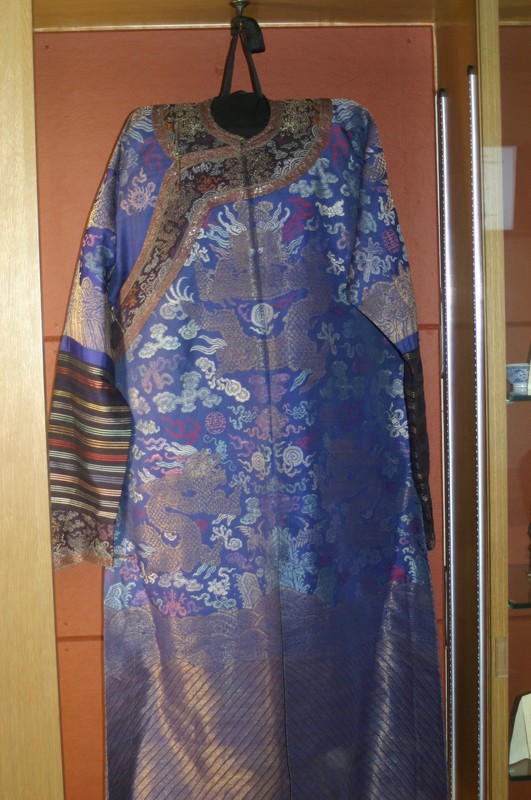
Green Kesi robe decorated with five-clawed dragons
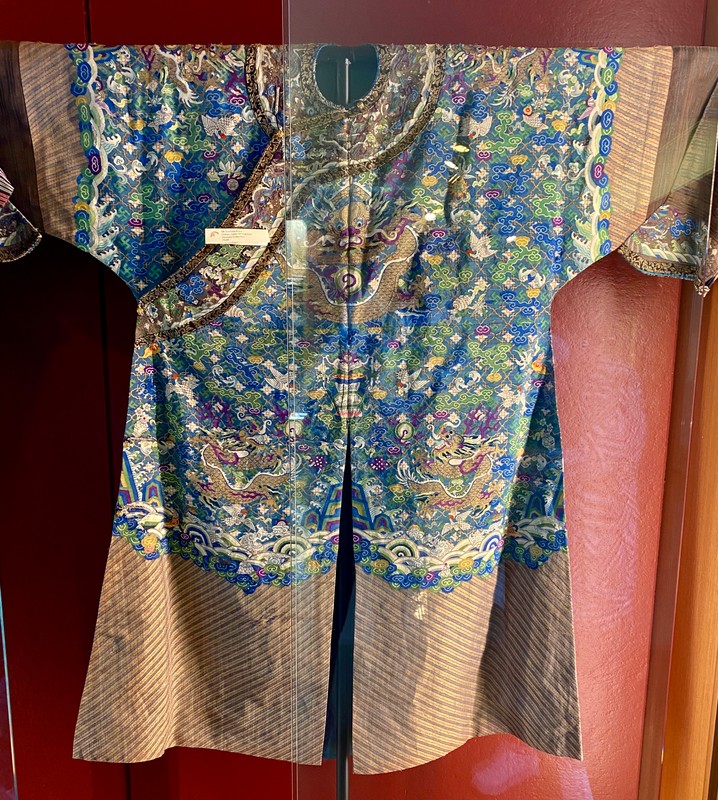
This red kesi short silk robe has Buddhist and Taoist symbols as well as eight dragons.
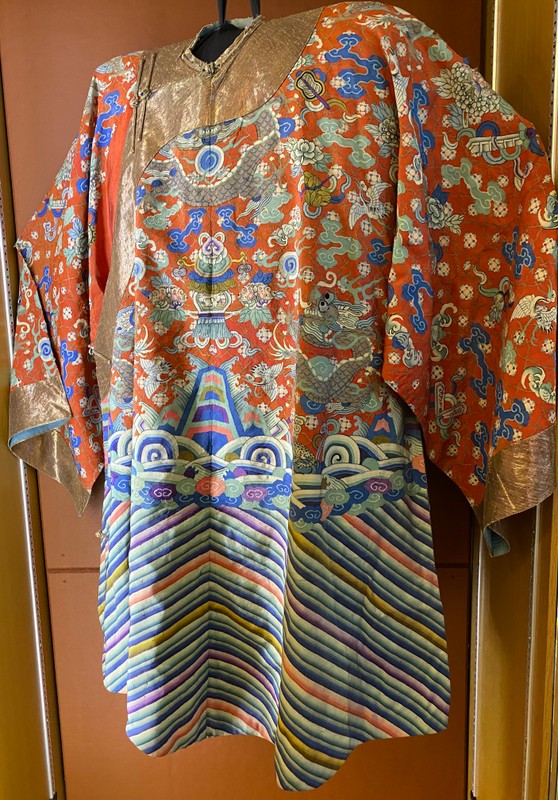
Black satin robe embroidered with cranes and flowers.
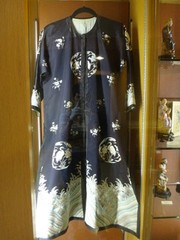
Summer Gauze Jacket with Crane Rank Badge
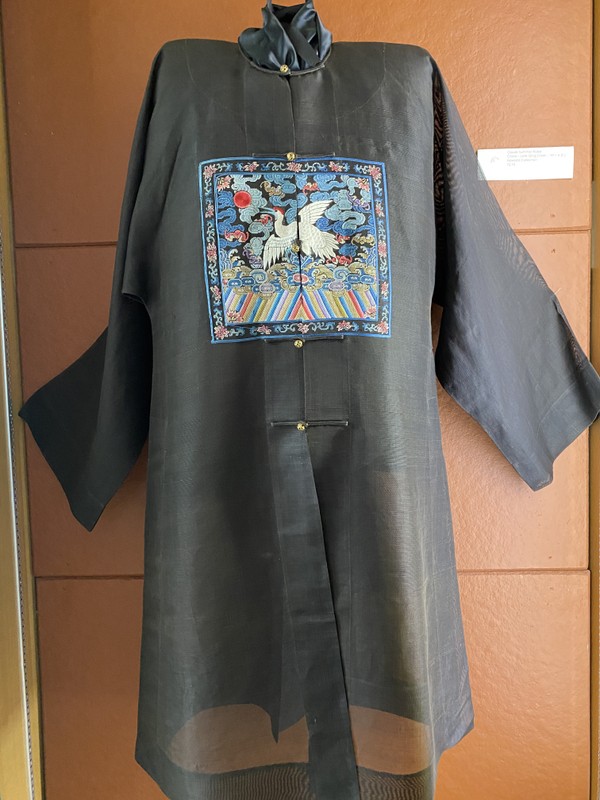
Notice the elaborate embroidery on this robe.
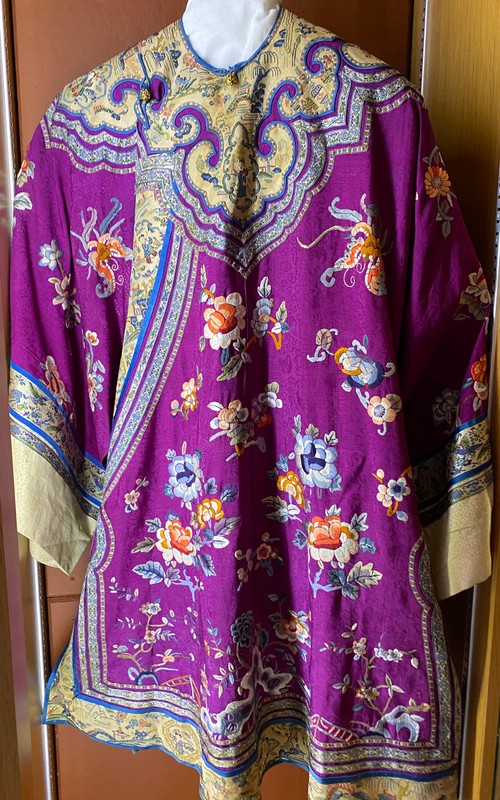
Ivory robe with embroidered flowers in six medallions..
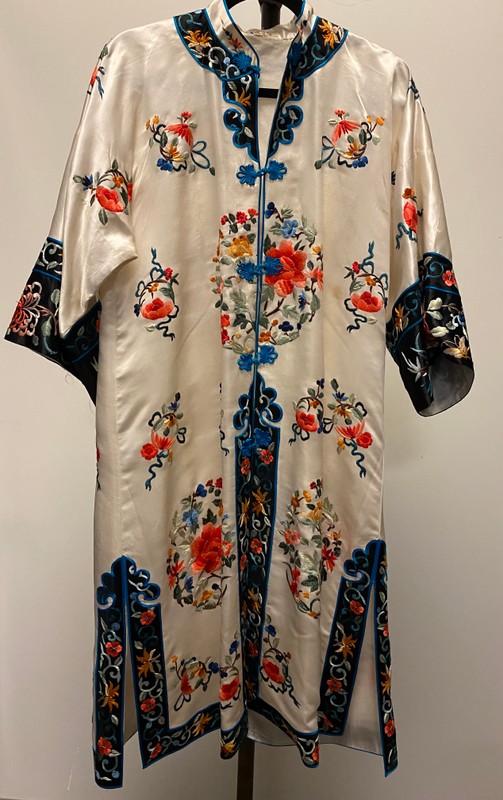
Chinese white satin robe with figures in six medallions.
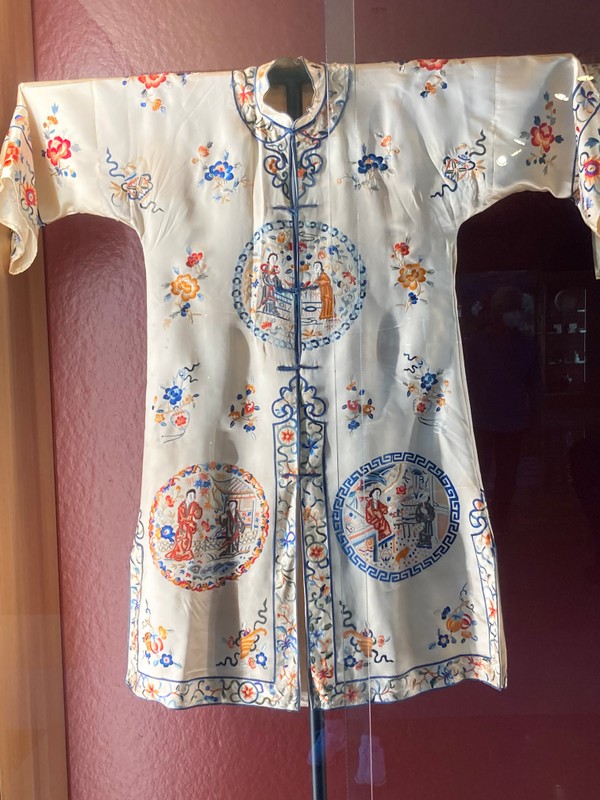
Semi-formal blue silk robe with six floral medallions
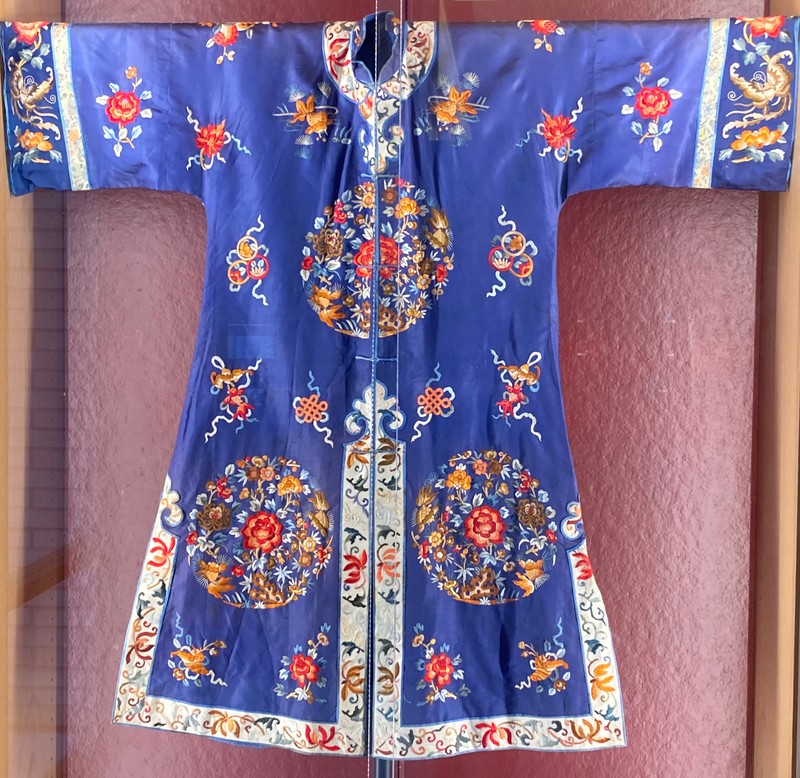
Semi-formal blue silk robe with embroidered flowers
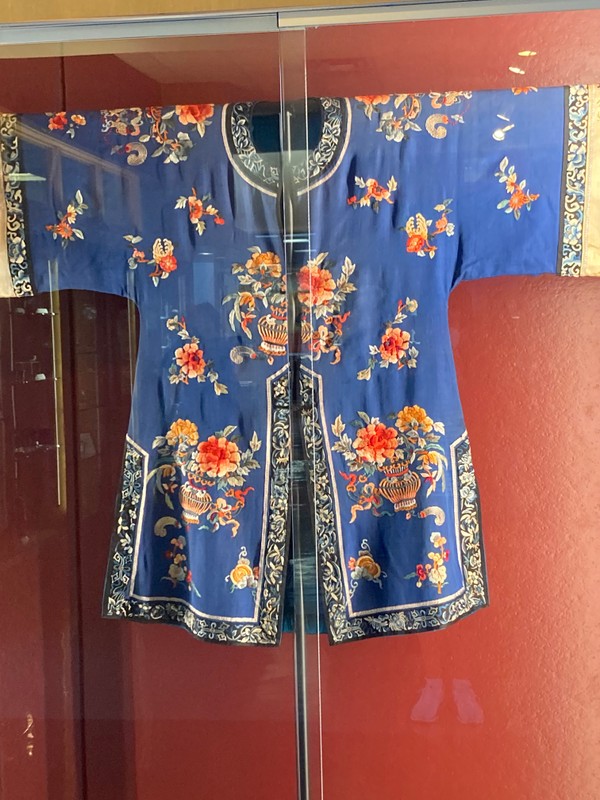
Semi-formal robe with embroidered flowers.
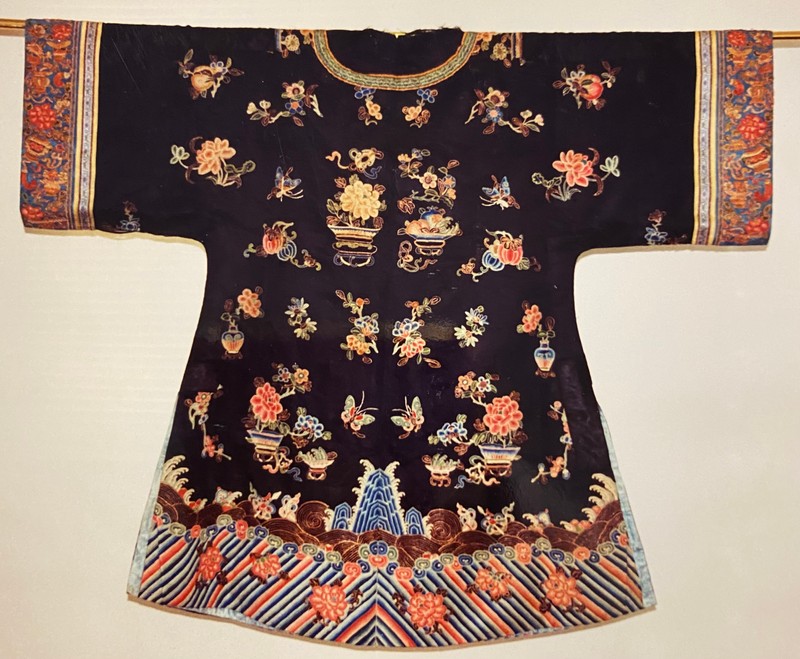
This coat is pictured with a Mandarin collar.
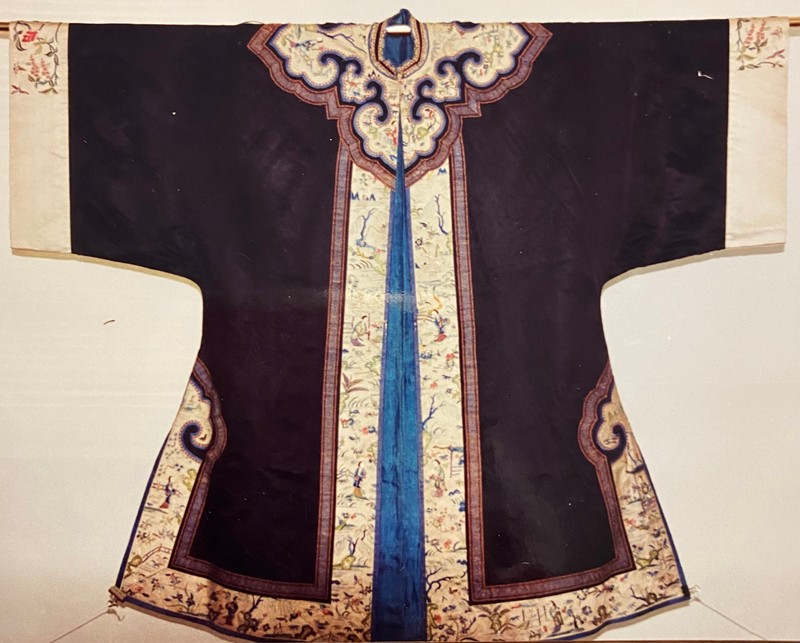
Observe the elaborately embroidered dragons and flowers.
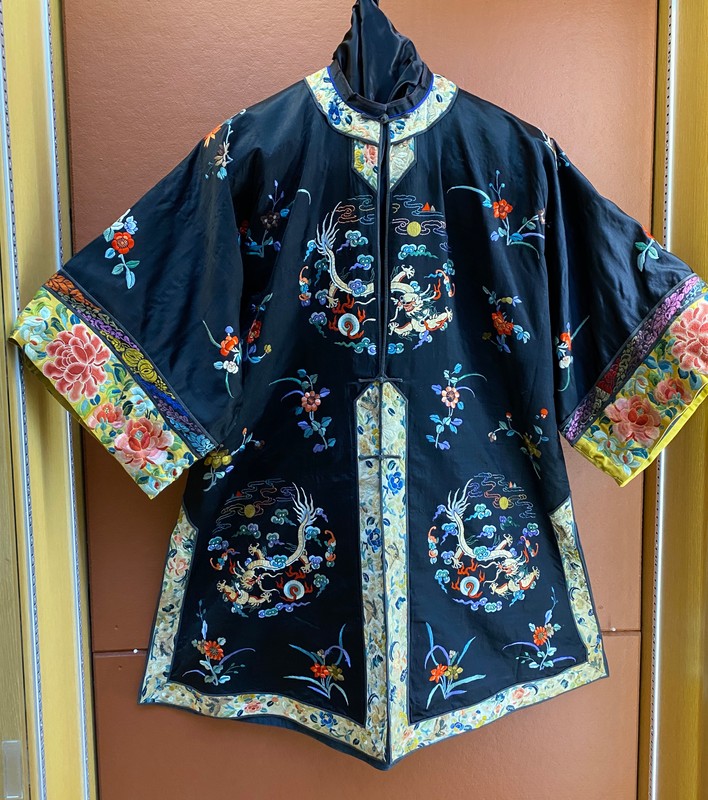
Although this jacket is now faded, we can still appreciate the intricate stitchery employed in the embroidered edges.
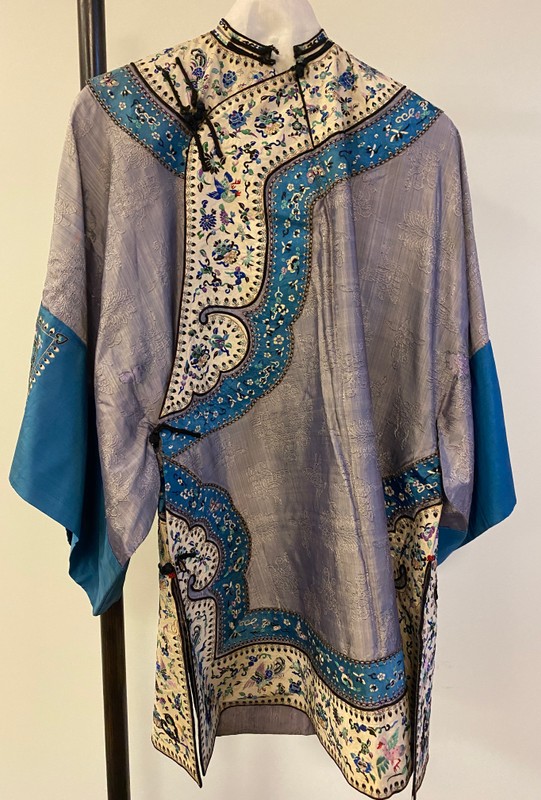
This rare Kesi jacket has four buttons marked W & R Smith and British lion decoration.
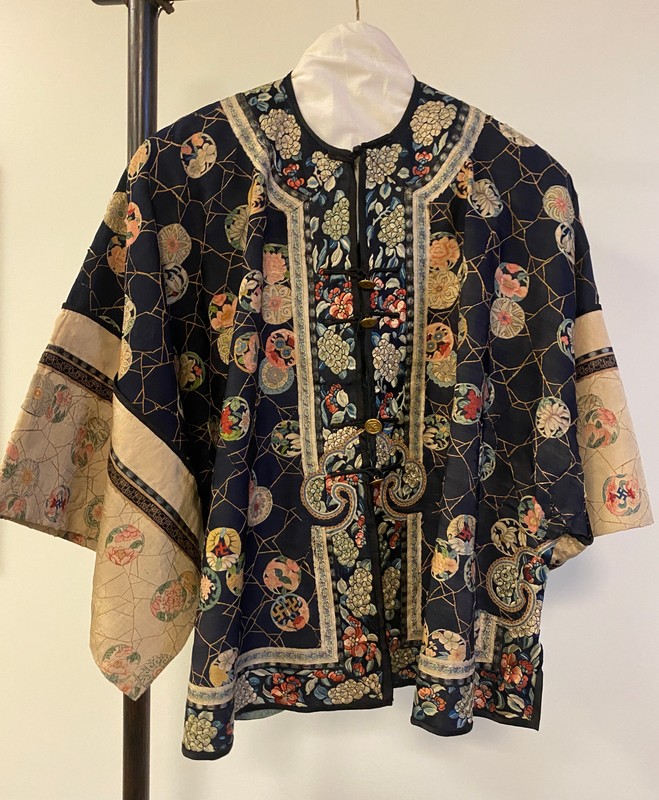
Embroidery Techniques explained
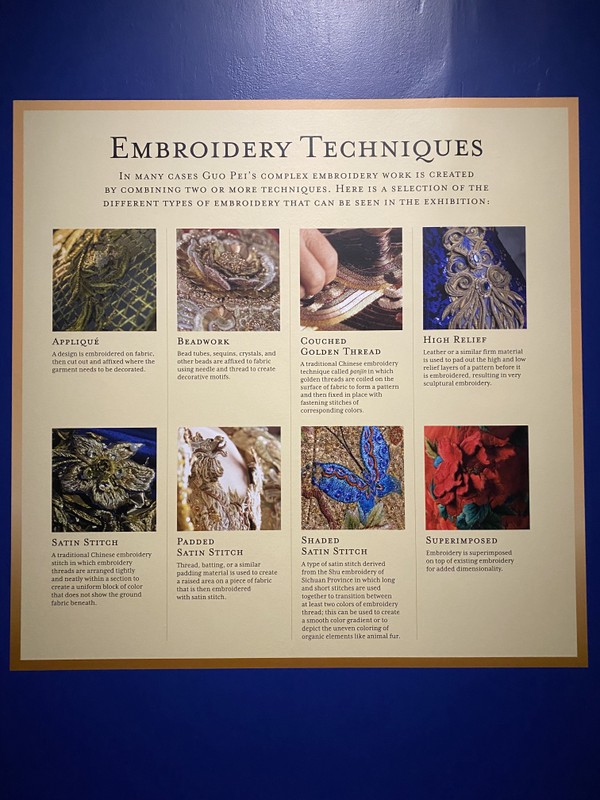
This photo shows the decoration around the Han wrap shirt.
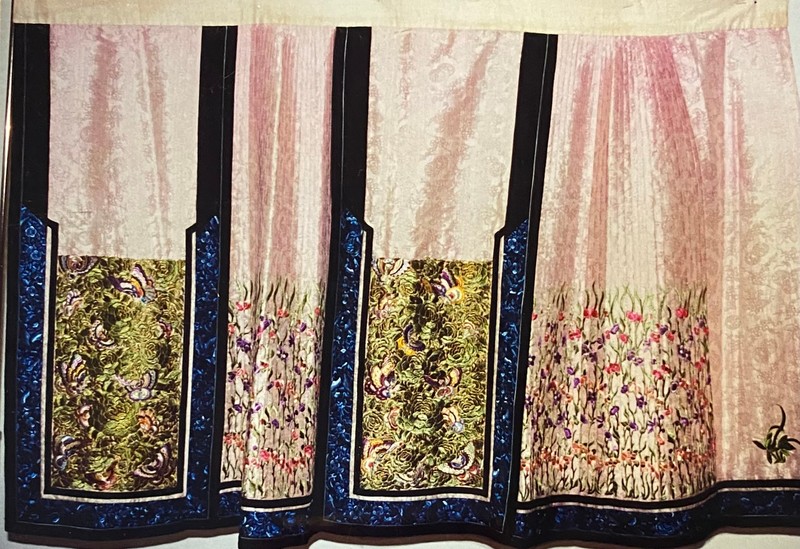
Difficult to see, a peacock stands proudly in the center of the central decoration.
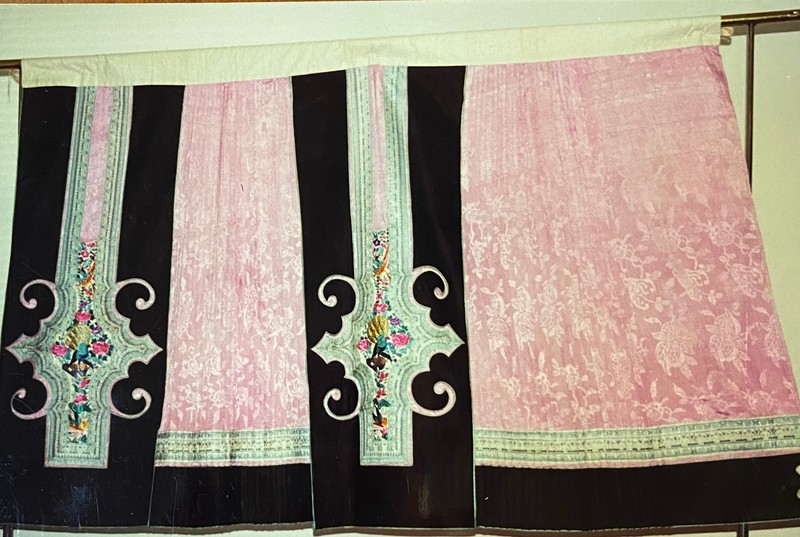
The white skirt has two full panels of flowers and smaller flowers on the sides and back.
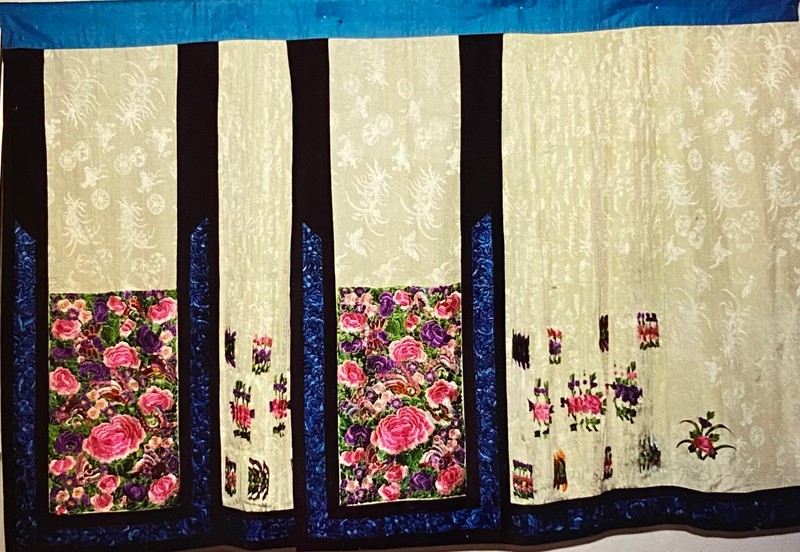
In the Green room, look at the folded orange skirt that shows how it would appear when worn.
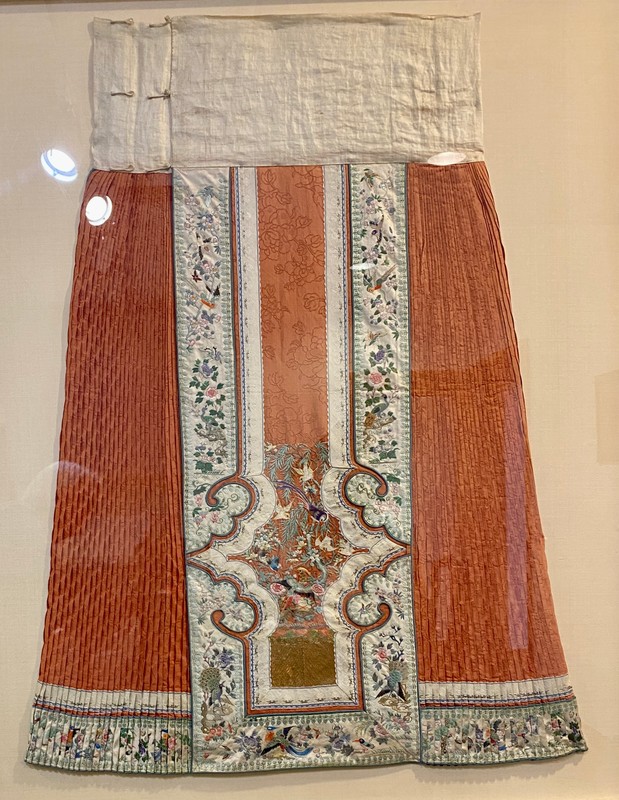
Two-piece wedding ensemble with elegant gold couching made in 1939.
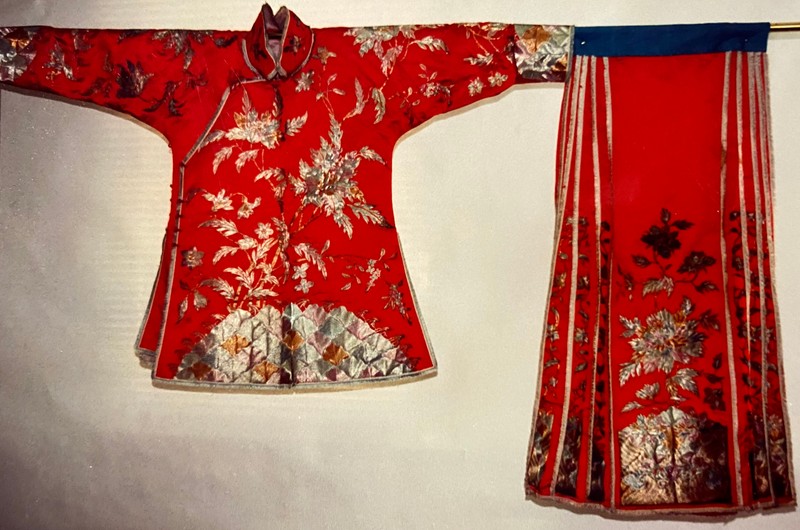
Early 20th Century women might have worn a cheongsam like this for special occasions.

Mrs. Howard collected almost 100 sleeve bands because of their exquisite embroidery.
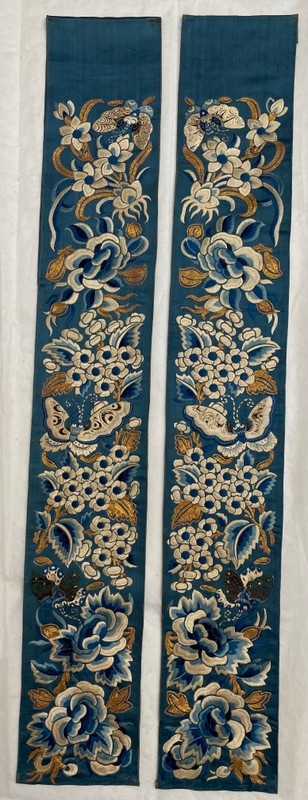
Various shades of blue flowers and birds are surrounded by gold couched thread.
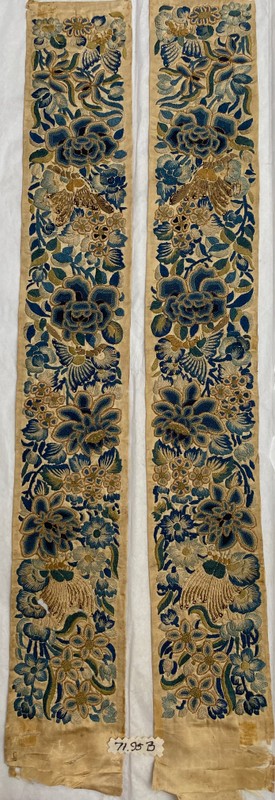
Detailed embroidery of flowers enhances these sleeve bands.
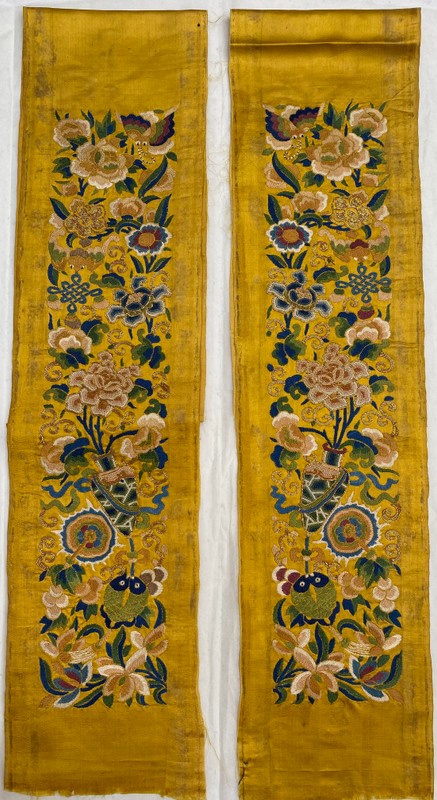
Notice the elaborate gold couching of butterflies and flowers on these sleeve bands.

Notice the dragon on the top right corner, a phoenix on the bottom left, and two protective Chi'li-in on the other two corners.
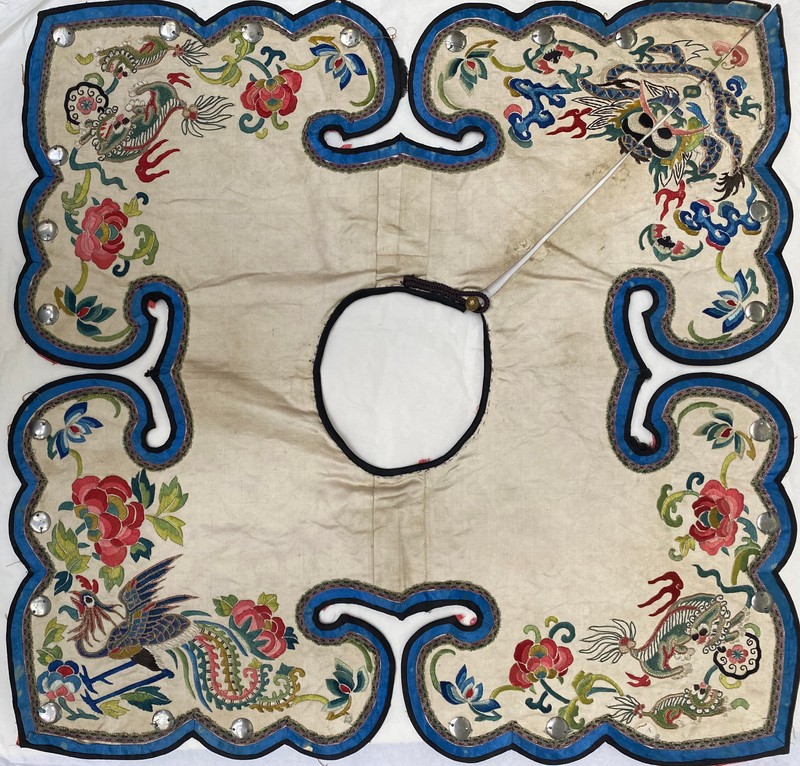
Embroidered flowers are featured on the corners of this cloud collar.
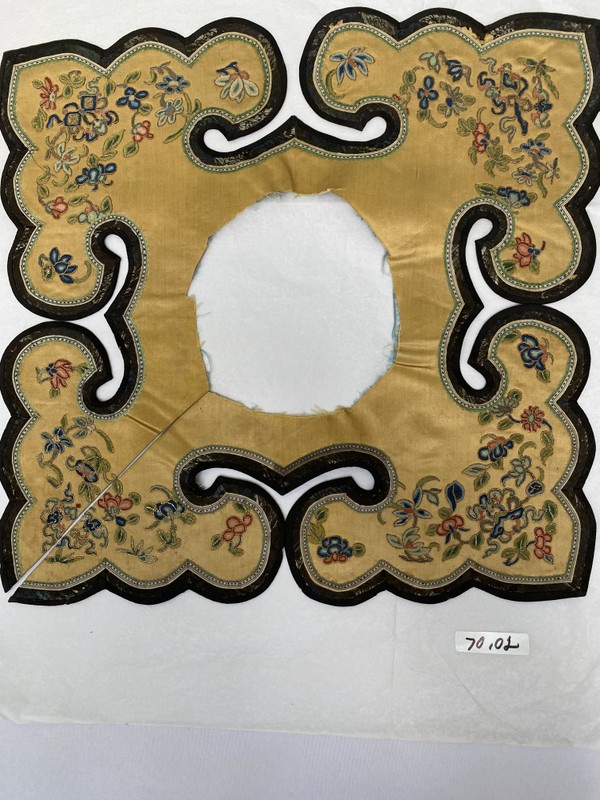
This multi-layered cloud collar would have been worn over a robe for decoration.
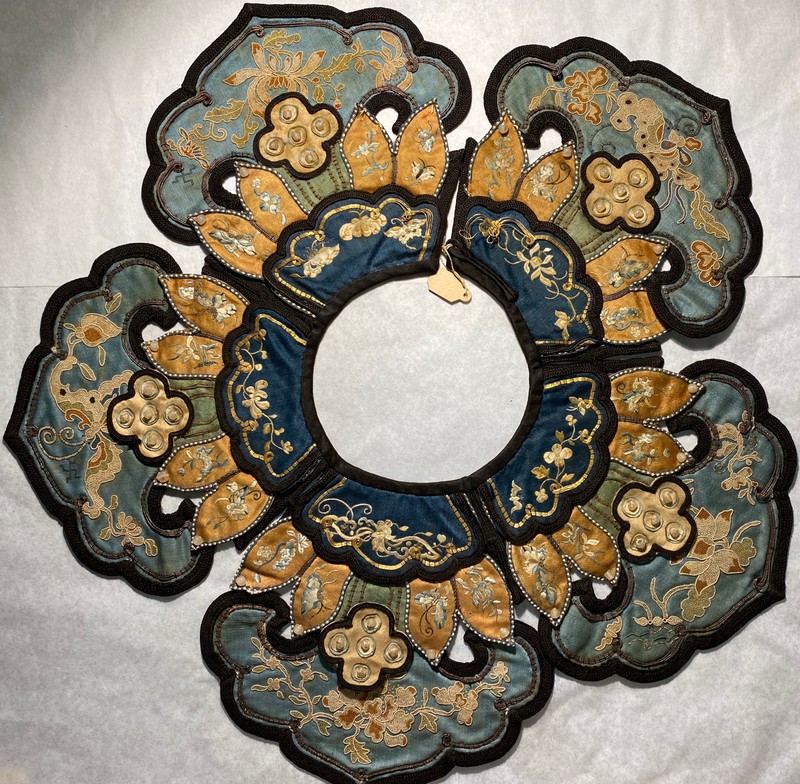
Three rows of shaped silk panels with embroidered flowers make this collar quite dramatic.
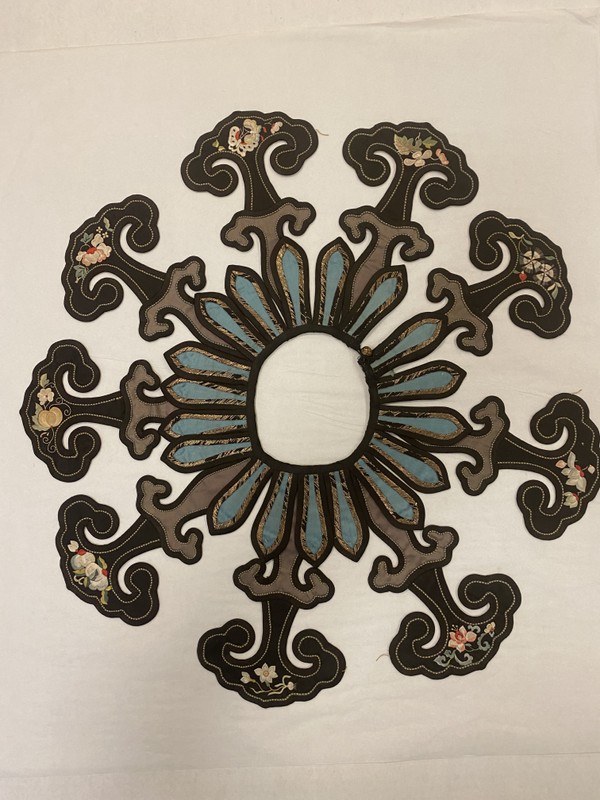
This unusual collar incorporates tassels and netting.
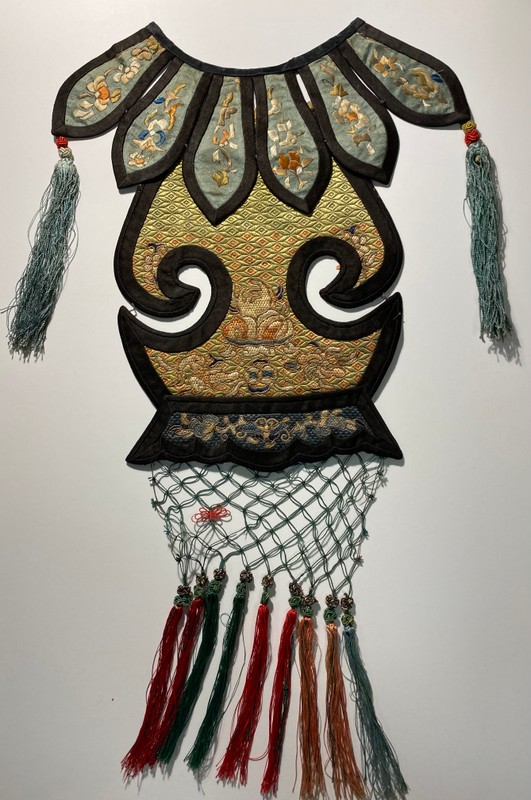
This collar has a combination of three tabs and multicolored tassels.
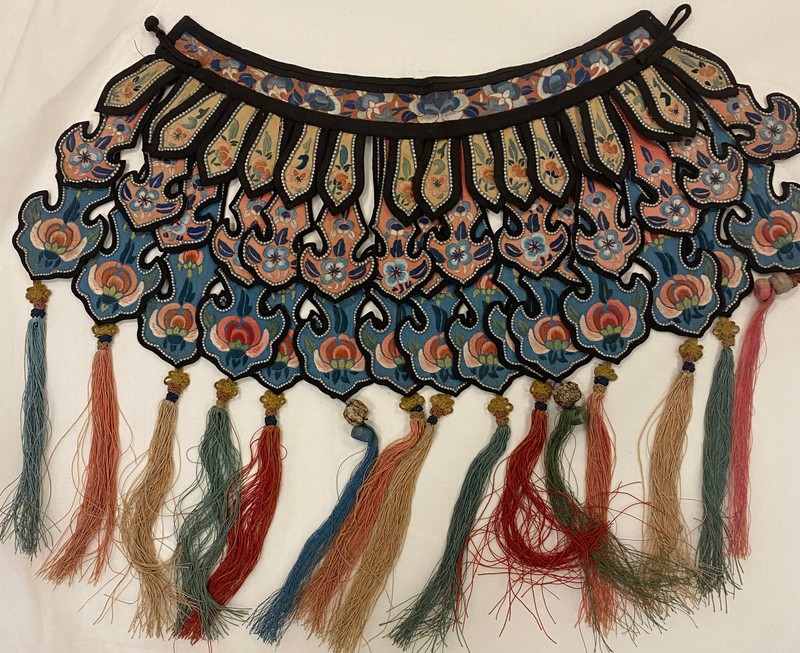
Each tab has a pearl at the tip!
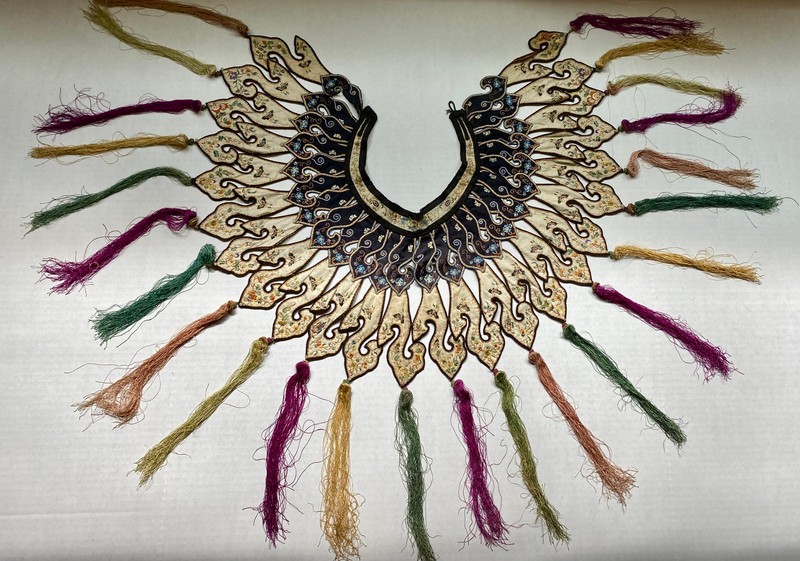
This wing-shaped Mandarin collar would have been worn by an important man. Dragons on the shoulders provide protection.
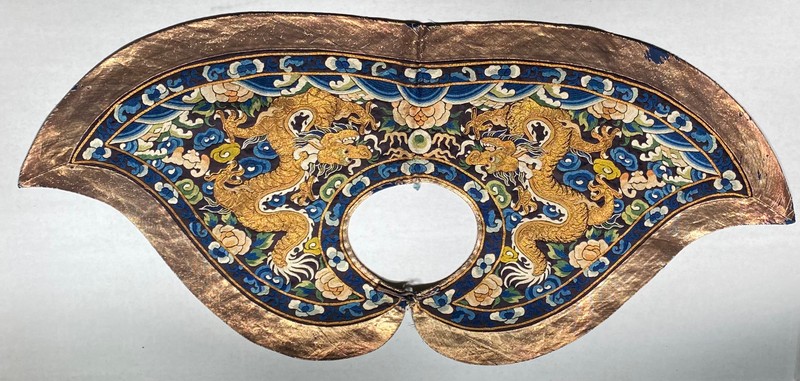
Exquisite embroidery, especially the gold couching, makes this a gorgeous collar.
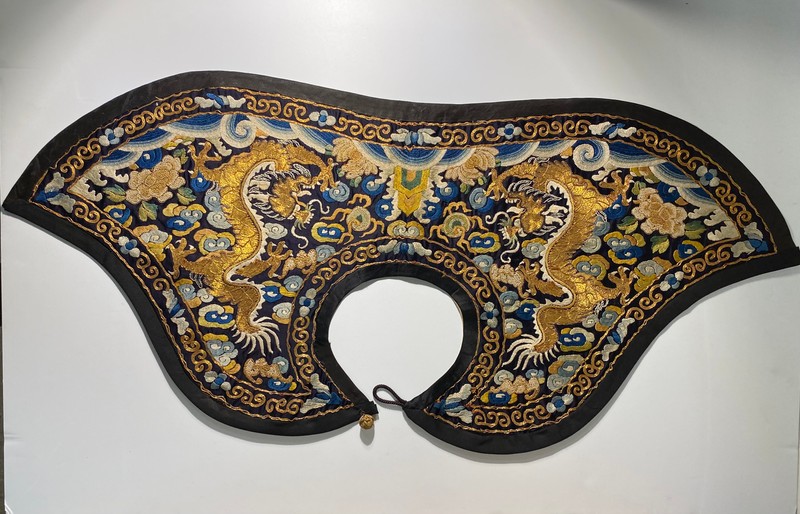
Chi'li-in, mythical creatures, protect the wearer of this collar.
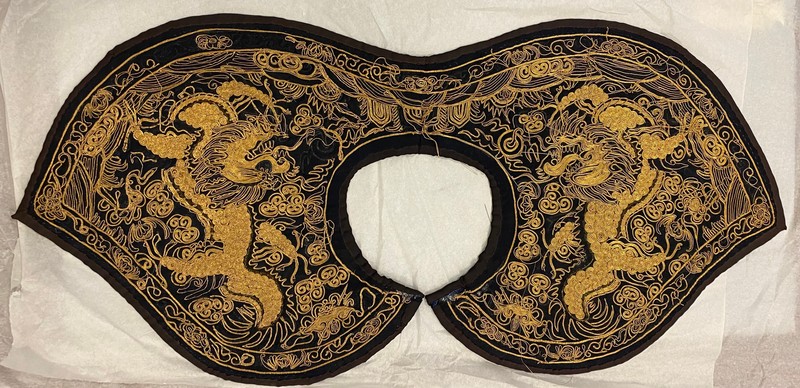
A scholar would be attired in this hat.
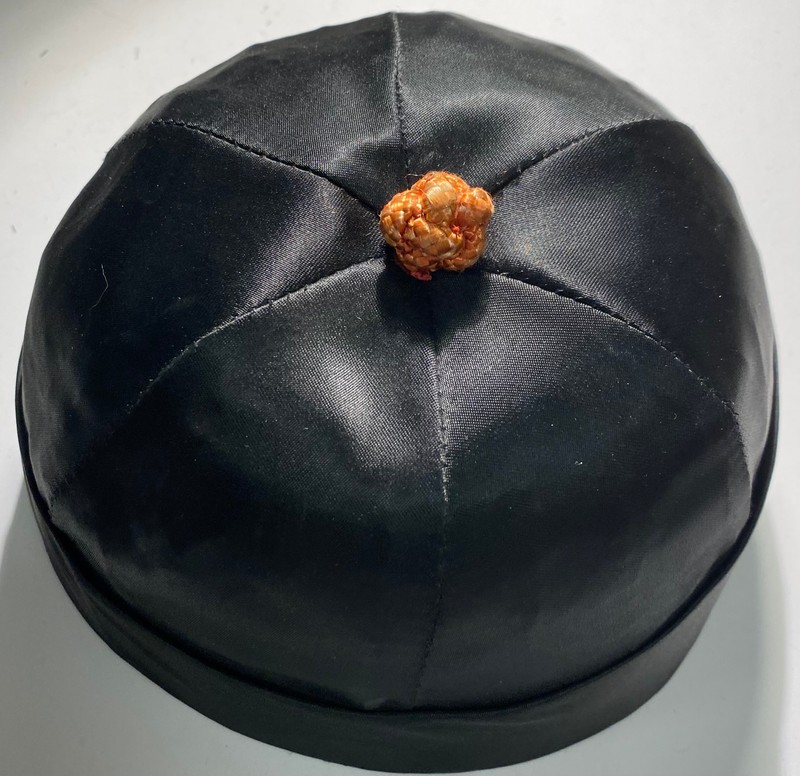
An elaborate lucky red tassel decorates this hat.
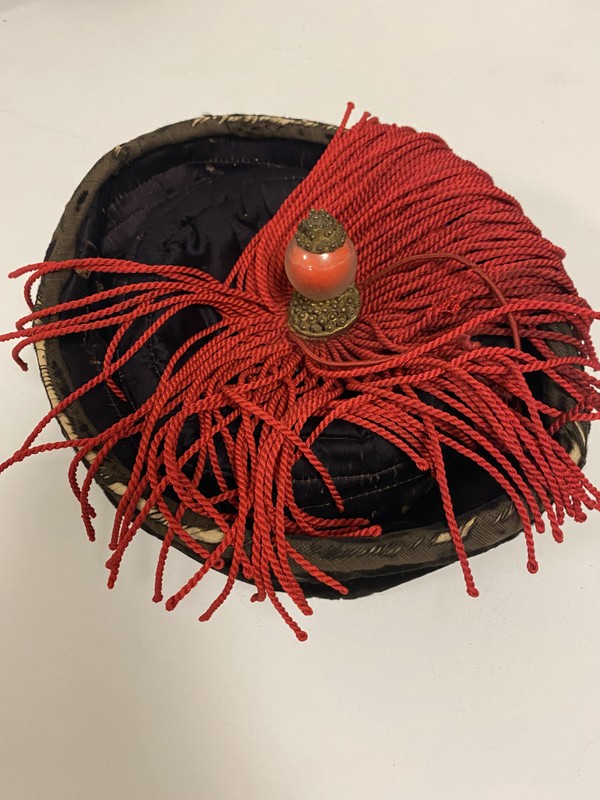
This highly decorated hat has a symbol of good fortune on the front.
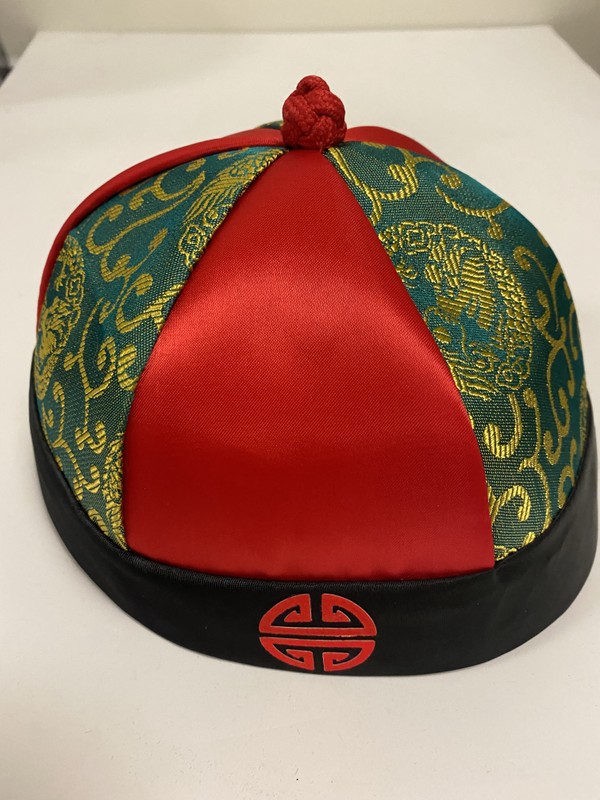
This hat was probably worn by a woman.

A theatrical representation of a hat that might be worn by a royal wife.
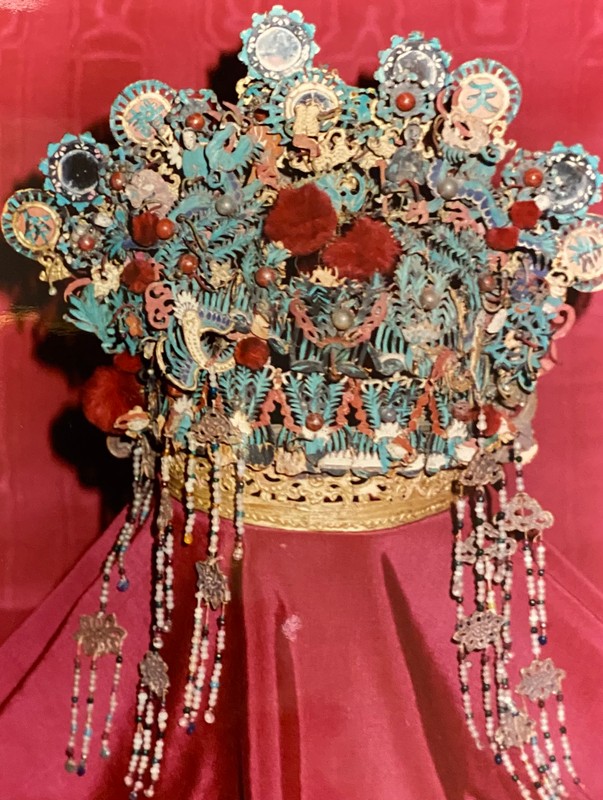
Blue on one side, and burnt orange color on the other--how practical!
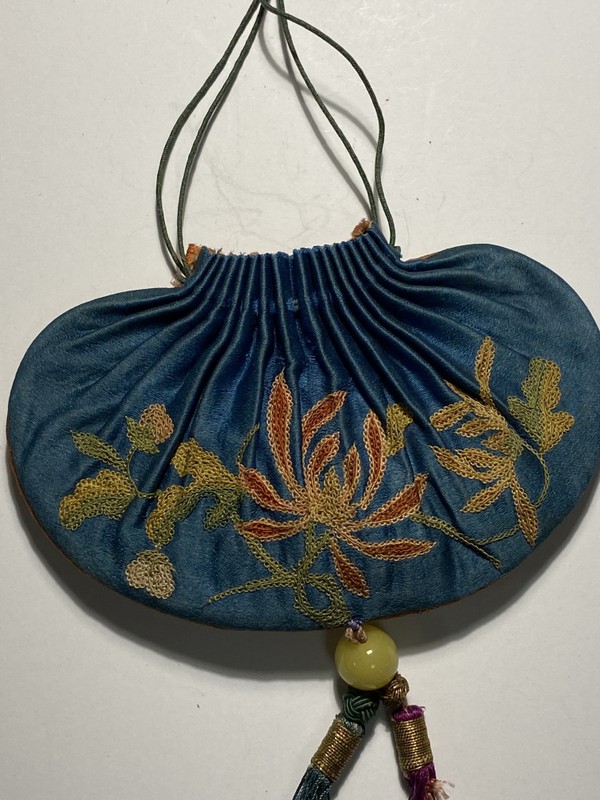
A popular style purse in the late 1800s.
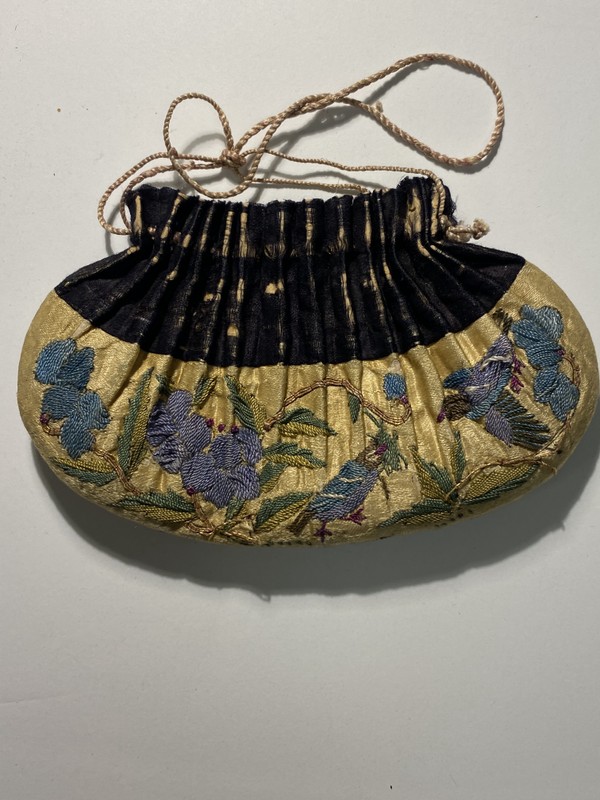
This dainty purse could only hold essentials.
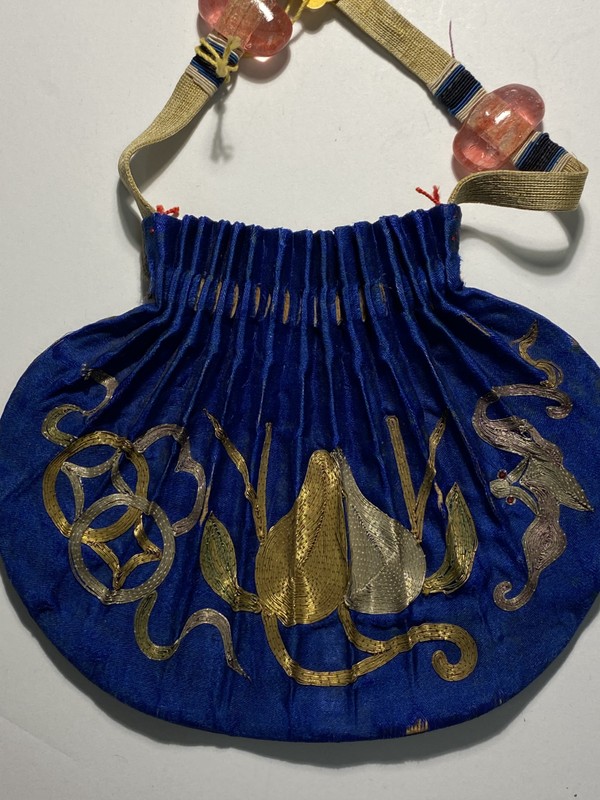
Backstory and Context
Text-to-speech Audio
Dress in the Qing Imperial Court...
There was never a doubt about a person's status and rank in the Qing Imperial Court—the clothes said it all. When the Manchu Qing rulers ousted the Han Ming dynasty in 1644, the new government outlined the only acceptable court dress. This was intended to clarify everyone's rank and status. Eventually the Qing even codified it in The Illustrated Catalogue of Ritual Paraphernalia, so that all Han as well as Manchu officials would conform to the emperor's wishes...
Color became the major indicator of status. Yellow, considered the most auspicious color, was reserved for the emperor and his royal family. Blue, the official Manchurian Qing dynasty color, could be worn by minor princes or noblemen, as could brown. Blue-black fabric was for court officials...
Clothing for conducting government business included the well-known jifu, or dragon robe, featured here in blue. Because the Manchu had a horse-riding tradition, this robe had a side-fastening jacket and featured horse-shoe cuffs, which were originally designed to cover a rider's hands in bad weather. The robe showed symbols of water and waves at the base, then symbols of the land with a central mountain, and finally cloud symbols of the heavens above, which combine to signify the emperor's total authority over the whole universe. The five-clawed dragon, universal symbol of the emperor, featured prominently. High ranking officials had eight five-clawed dragons visible, with a ninth dragon hidden inside a front flap...
A jifu robe was worn with a collar, a hat, a long string of court beads, and an outer coat displaying a rank badge. This badge was an embroidered square worn on the back and front. Civil and military ranks were each divided into nine levels, with birds denoting a civil rank and real or mythological animals indicating a military rank. Civil ranks were awarded to scholars following grueling exams based on Confucianism and the classics of Chinese literature. Military ranks were awarded after tests on military subjects and skills. The Qing Manchu rulers adopted this system of governance by meritocracy that had existed in China since 1391...
Proper attire was also regulated by season. The dates, and even the exact hours, for changing from one season to the other were strictly outlined. Winter robes would be lined or edged with fur and padded. Summer robes would be lined with silk or made of gauze and worn over cool jackets of bamboo. A black summer gauze outer robe with rank badge can be seen in the John Fielder and Donita Van Horik Display Case outside the Breslauer Room...
Women's Clothing...
Women were seldom involved in court proceedings, so few examples remain of a woman's dragon robe jifu. However, women did wear the same rank badge as their husband or father, and rare examples of these are in the Howard collection. They wore the rank badge on an outer coat or a fringed vest called a xiape. A popular custom grew of placing the bird or animal insignia mirroring her husband’s, so that that they would be facing each other when they were seated together at official functions...
Affluent women wore a combination of a side-or-front fastening robe over a wrap-around pleated apron skirt. These robes were decorated lavishly with embroidery. By the time of Empress Dowager Cixi, toward the end of the Qing dynasty in 1912, the vogue among noblewomen was for bold, floral designs. Robes were embellished further with sleeve bands embroidered with flowers, butterflies, or figural scenes. The silk skirts were likewise beautifully embroidered on the front aprons and even on the inside of the narrowest of pleats. Examples of three of these skirts are framed and hanging in the Breslauer Room and another one is in the president’s office...
Decorative Techniques...
Decoration comprises much of the aesthetic value of Chinese imperial court clothing, and great attention was paid to achieving perfectly woven silk fabric and exquisitely stitched embroidery. One of the special techniques of weaving was known as kesi or cut silk. It created the appearance of cut threads in blocks of colors on the robes. Embroidery featured special techniques, too. The so-called “forbidden stitch" was said to be so fine that it would cause blindness. Of course, we have no evidence of this, but this seed stitch or Peking knot was often used for detailing in small areas. Another special technique was called couching, where gold-wrapped silk thread would be laid on top of the fabric and held in place by over-stitching...
Cite This Entry
STW on behalf of Assistance League of Long Beach. "Chinese Imperial Clothing." Clio: Your Guide to History. January 2, 2024. Accessed April 2, 2025. https://theclio.com/entry/171773
Sources
Xun, Zhou and Gao Chunming. 5000 Years of Chinese Costumes. Edited by: The Chinese Costumes Research Group of the Shanghai School of Traditional Operas. The Commercial Press Ltd. Hong Kong. 1988
Whitfield, Susan. Life Along the Silk Road. University of California Press. Berkeley. 1999
“World Leaders in Silk Production.” World Atlas. Accessed November 8, 2023. https://www.worldatlas.com/articles/world-leaders-in-silk-production.html.
“Silk History.” Silk Road. Accessed November 6, 2023 http://www.silk-road.com/artl/silkhistory.shtml/
“Collecting Guide: Chinese Robes.” Christies. 2023 Accessed October 30, 2023. https://www.christies.com/en/stories/chinese-robes-collecting-guide-fe2dc4625607402dac039311320a3700
Howard Collection 75.08
Howard Collection 75.20
Howard Collection 75.20
Howard Collection 75.01
Howard Collection 75.23
Howard Collection 75.04
Howard Collection 75.05
Howard Collection 75.12
Howard Collection 75.10
Asian Art Collection 75.29.15
Asian Art Collection 75.29.04
Asian Art Collection 75.29.05
Asian Art Collection 75.29.13
Asian Art Collection 75.29.11
Asian Art Collection 75.19
Asian Art Collection 75.29.14
Howard Collection 75.29.08
Asian Art Collection 75.29.06
Asian Art Collection 75.39.04
Bowers Museum Display for the Guo Pei Exhibit in March 2023.
Howard Collection 75.50.34
Howard Collection 75.50.33
Howard Collection 75.50.27
Howard 75.50.35
Asian Art Collection 75.43.01 A-B
Howard Collection 75.61
Howard Collection 71.95 C
Howard Collection 71.95 B
Howard Collection 71.33
Howard Collection 71.05
Howard Collection 70.19
Howard Collection 70.02
Howard Collection 70.05
Howard Collection 70.26
Howard Collection 70.24
Howard Collection 70.25
Howard Collection 70.10
Howard Collection 70.11
Howard Collection 70.23
Howard Collection 70.29
Howard Collection 74.31
Howard Collection 74.30
Howard Collection 74.46
Asian Art Collection 74.34
Howard Collection 99.01
Howard Collection 74.23
Howard Collection 74.18
Howard Collection 74.16

